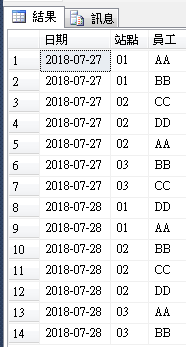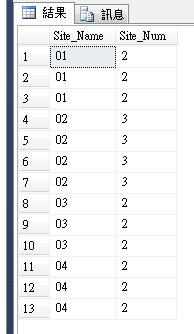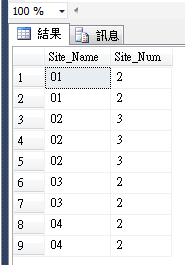我又來出題了@@...這個有解完才放出來XD
這題應該有點難,我是用TSQL處理出來的..
假設有4位員工 AA BB CC DD
站點有01 02 03
01需要2位員工
02需要3位員工
03需要2位員工
因為是採輪班方式,故前天的員工未排到的~則當天會從第1位開始排~
圖片結果:
歡迎各位高手試試~
之後我再把我的寫法放出來參考~@@"
先貼出我的基本設定方式~
declare @Emp table(
Emp_ID int
,Emp_Name nvarchar(50)
)
insert into @Emp
values(1,'AA')
,(2,'BB')
,(3,'CC')
,(4,'DD')
declare @Site table(
Site_ID int
,Site_Name nvarchar(50)
,Site_Num int
)
insert into @Site
values(1,'01',2)
,(2,'02',3)
,(3,'03',2)
declare @Users table(
Users_Date date
,Users_Site nvarchar(50)
,Users_EmpID int
,Users_Emp nvarchar(50)
)
declare @StartDate date,@EndDate date,@SetDate date,@i int,@Count int
declare @j int,@Sub_Count int,@SetSite nvarchar(50),@SetNum int
set @StartDate = '2018/7/27'
set @EndDate = '2018/7/28'
set @Count = DateDiff(day,@StartDate,@EndDate)
set @i = 0
SQL參考~
while(@i<=@Count)
begin
set @SetDate = dateadd(day,@i,@StartDate)
set @j = 1
select @Sub_Count = count(*)
from @Site
while(@j<=@Sub_Count)
begin
select @SetSite = Site_Name
,@SetNum = Site_Num
from @Site
where Site_ID = @j
insert into @Users
select top (@SetNum)
@SetDate
,@SetSite
,Emp_ID
,Emp_Name
from (
select *
,isNull((
select count(*)
from @Users
where Users_EmpID = Emp_ID
),0) as Emp_Num
from @Emp
) as k
order by Emp_Num
set @j = @j + 1
end
set @i = @i + 1
end
select Users_Date
,Users_Site
,Users_Emp
from @Users
![]() rogeryao比較厲害~這次SQL直接算出循環排班~哈
rogeryao比較厲害~這次SQL直接算出循環排班~哈

http://sqlfiddle.com/#!18/f8707c/2
CREATE TABLE Emp ([Num] varchar(2)) ;
INSERT INTO Emp ([Num]) VALUES ('AA'), ('BB'), ('CC'), ('DD') ;
CREATE TABLE Center ([ID] varchar(2), [EmpQty] int) ;
INSERT INTO Center ([ID], [EmpQty]) VALUES ('01', 2), ('02', 3), ('03', 2) ;
CREATE TABLE WorkDate ([SchDate] varchar(10)) ;
INSERT INTO WorkDate ([SchDate]) VALUES ('2018-07-27') ;
INSERT INTO WorkDate ([SchDate]) VALUES ('2018-07-28') ;
INSERT INTO WorkDate ([SchDate]) VALUES ('2018-07-29') ;
select d.Row1,d.SchDate,d.ID,e.Num
from (
select ROW_NUMBER() OVER(ORDER BY f.SchDate,c.ID) AS Row1,f.SchDate,c.ID,c.EmpQty
from WorkDate as f ,(
select b.ID,b.EmpQty
from Center as a
Cross Apply Center as b
where 1=1
and a.EmpQty<=b.EmpQty
) as c
) as d
left join
(select (ROW_NUMBER() OVER(ORDER BY Num asc) %4 ) AS Row2,Num from Emp) as e
on d.Row1 % 4 = e.Row2
哈~~這厲害~直接算出循環排班!!![]()
真的厲害! ![]()
今天再來看發現圖片點錯... Sorry
研究了一下Cross apply
發現在新增站點就會有問題呢@@a
declare @Site table(
Site_Name nvarchar(2)
,Site_Num int
)
insert into @Site
values('01',2)
,('02',3)
,('03',2)
,('04',2)
select b.Site_Name
,b.Site_Num
from @Site as a
Cross apply @Site as b
where a.Site_Num <= b.Site_Num

暐翰rogeryao
喔喔!我瞭解Cross apply其實就是相乘~
所以當資料只有1筆的時候~只會1 * 1
但資料有2筆時就是 2 * 2 依此類推~
所以修正這個Bug問題~
就是還是先列出全清單或少資料就直接建
直接建:
站點 人數
01 2
01 2
如果4筆站點加總有大於員工數量就可以Cross apply
例如4 * 4 = 16 >= 2 + 3 +2 +2 就可以用全清單方式@@a
declare @Site table(
Site_Name nvarchar(2)
,Site_Num int
)
insert into @Site
values('01',2)
,('02',3)
,('03',2)
,('04',2)
select Site_Name
,Site_Num
from (
select Row_Number()Over(Partition by b.Site_Name order by b.Site_Name) as Sort
,b.Site_Name
,b.Site_Num
from @Site as a
Cross apply @Site as b
) as k
where Sort <= Site_Num
--Cross apply 相同道理
select Site_Name
,Site_Num
from (
select Row_Number()Over(Partition by b.Site_Name order by b.Site_Name) as Sort
,b.Site_Name
,b.Site_Num
from @Site as a
, @Site as b
) as k
where Sort <= Site_Num

CREATE TABLE Emp ([Num] varchar(2)) ;
INSERT INTO Emp ([Num]) VALUES ('AA'), ('BB'), ('CC'), ('DD') ;
單站最大員工數 2048
CREATE TABLE Emp ([Num] varchar(2)) ;
INSERT INTO Emp ([Num]) VALUES ('AA'), ('BB'), ('CC'), ('DD') ;
CREATE TABLE Center ([ID] varchar(2), [EmpQty] int) ;
INSERT INTO Center ([ID], [EmpQty]) VALUES ('01', 2), ('02', 3), ('03', 2), ('04', 2), ('05', 4) ;
單站最大員工數=Emp 員工數
喔喔!~
1.利用master..spt_values資料呀~第一次看到這麼用@@~
2.利用員工數去配~第2點比較合理~不然同一個站點~員工就配了2次~![]()
我的解法也是寫一個SP,邏輯寫在註解裡面
有想到優化方式,再來優化 :D
TEST DDL:
CREATE TABLE Emp ([ID] varchar(2)) ; INSERT INTO Emp ([ID]) VALUES ('AA'), ('BB'), ('CC'), ('DD') ;
CREATE TABLE Center ([ID] int, [EmpQty] int) ; INSERT INTO Center ([ID], [EmpQty]) VALUES (01, 2), (02, 3), (03, 2) ;
CREATE TABLE Sch ([Datetime] datetime, [CenterID] int, [EmpID] varchar(2)) ;
SP:
CREATE PROCEDURE SP_SCH_Center_ByEmp
@v_date datetime
AS
declare @v_firstEmp nvarchar(2) = (
--找出昨天誰排班最少,藉由group + rownumber count,接著篩選出rank = 1的資料
select [EmpID]
from (
select [EmpID]
,row_number() over (order by count(1),[EmpID]) rnk
from Sch
where [Datetime] = (@v_date-1)
group by [EmpID]
) T where rnk = 1
);
declare @v_empCount int = (select count(1) from Emp);
--如果@v_firstEmp沒資料,以第一個員工為準
--如果@v_firstEmp有資料,以前天排最少班的第一個員工為準
if @v_firstEmp is null begin
select @v_firstEmp = (select top 1 [ID] from Emp);
end;
--先把當天Center資料展出來(使用遞迴)
WITH CTE AS (
SELECT 1 as Number,ID,EmpQty from Center
UNION ALL
SELECT Number+1,ID,EmpQty
FROM CTE
WHERE Number < EmpQty
)
--幫員工做一個排序
,CTE2 as (
select * , row_number() over (order by [ID] ) rnk from Emp
)
--Center資料做一個排序,特別使用站點排名 + @v_firstEmp員工的排名-2 做%的基準數
,CTE3 as (
SELECT @v_date [Datetime],ID [CenterID]
,( row_number() over (order by [ID])
+ (select rnk - 2 from CTE2 where [ID] = @v_firstEmp )
) rnk
FROM CTE
)
insert into sch
select T1.[Datetime],T1.[CenterID],T2.[ID]
from CTE3 T1
left join CTE2 T2 on ((T1.rnk) % (@v_empCount)) = T2.rnk-1;
測試新增7/27,28的資料
exec SP_SCH_Center_ByEmp '2018-07-27';
exec SP_SCH_Center_ByEmp '2018-07-28';
select * from SCH;
得到結果:
| Datetime | CenterID | EmpID |
|---|---|---|
| 2018/7/27 | 1 | AA |
| 2018/7/27 | 1 | BB |
| 2018/7/27 | 2 | CC |
| 2018/7/27 | 2 | DD |
| 2018/7/27 | 2 | AA |
| 2018/7/27 | 3 | BB |
| 2018/7/27 | 3 | CC |
| 2018/7/28 | 1 | DD |
| 2018/7/28 | 1 | AA |
| 2018/7/28 | 2 | BB |
| 2018/7/28 | 2 | CC |
| 2018/7/28 | 2 | DD |
| 2018/7/28 | 3 | AA |
| 2018/7/28 | 3 | BB |
| 2018/7/29 | 1 | CC |
| 2018/7/29 | 1 | DD |
| 2018/7/29 | 2 | AA |
| 2018/7/29 | 2 | BB |
| 2018/7/29 | 2 | CC |
| 2018/7/29 | 3 | DD |
| 2018/7/29 | 3 | AA |
另外,這間公司這麼血汗,一個人排這麼多點站一天 XDD
哈~還好啦~不要超過法令8小時就沒問題了@@a
7/27
AA BB CC 都是2個站點
DD 是1個站點
也就每個人每天大約會要去兩個站點維護@@"
果然這題輪班~SQL有點難做~@@a
實務上排班要實際建檔,才能確認前一天到底誰最後~
(因為可能請假不在)
若純粹玩SQL 用暫存就可以了XD..
感覺用純SQL會不好維護呢
假如遇到這種需求我還是會用後端程式來跑順序邏輯
這樣遇到鳥客戶的千變萬化需求,也比較好調整 XDD
比如:
中間客戶提出需求,預設是照大大的邏輯,但也可以人工決定隔天的第一順序
最後,感謝大大提供好玩的題目 ![]()
其實輪班狀況很多~例如~請假不在~臨時調班~翹班~之類的狀況@@a
還要看上班地點打卡是否確實~
暐翰
ok~我也把我寫的方式~放出來參考@@"
你再看看~什麼可以改的~
好喔 我先煮完晚餐給家人有時間來想優化方式
create table ithelp180727_emp (
id serial primary key
, ename text not null
);
insert into ithelp180727_emp (ename) values
('AA'), ('BB'), ('CC'), ('DD');
create table ithelp180727_stat (
sid serial primary key
, matching int not null
);
insert into ithelp180727_stat values
(1, 2), (2, 3), (3, 2);
--
with st1 as (
select max(matching) mm
from ithelp180727_stat
), st2 as (
select count(*) as cnt
from ithelp180727_emp
), st3 as (
select date '2018-07-27' + d as dt
, sid
from st1
, generate_series(1, st1.mm) as i
, generate_series(1, i) as j
, generate_series(0, 1) as d
, ithelp180727_stat s
where s.matching = i
), st4 as (
select *
, row_number() over(order by dt, sid) rn
from st3
), st5 as (
select dt, sid, rn
, ntile(st2.cnt::integer) over(order by mod(rn::integer - 1, st2.cnt::integer)) as asgnemp
from st4
, st2
)
select dt, sid, ename
from st5
, ithelp180727_emp e
where st5.asgnemp = e.id
order by dt, sid, rn
;
dt | sid | ename
------------+-----+-------
2018-07-27 | 1 | AA
2018-07-27 | 1 | BB
2018-07-27 | 2 | CC
2018-07-27 | 2 | DD
2018-07-27 | 2 | AA
2018-07-27 | 3 | BB
2018-07-27 | 3 | CC
2018-07-28 | 1 | DD
2018-07-28 | 1 | AA
2018-07-28 | 2 | BB
2018-07-28 | 2 | CC
2018-07-28 | 2 | DD
2018-07-28 | 3 | AA
2018-07-28 | 3 | BB
(14 筆資料列)
----------------------
insert into ithelp180727_stat values (4,1);
-- 指令一樣
with st1 as (
select max(matching) mm
from ithelp180727_stat
), st2 as (
select count(*) as cnt
from ithelp180727_emp
), st3 as (
select date '2018-07-27' + d as dt
, sid
from st1
, generate_series(1, st1.mm) as i
, generate_series(1, i) as j
, generate_series(0, 1) as d
, ithelp180727_stat s
where s.matching = i
), st4 as (
select *
, row_number() over(order by dt, sid) rn
from st3
), st5 as (
select dt, sid, rn
, ntile(st2.cnt::integer) over(order by mod(rn::integer - 1, st2.cnt::integer)) as asgnemp
from st4
, st2
)
select dt, sid, ename
from st5
, ithelp180727_emp e
where st5.asgnemp = e.id
order by dt, sid, rn
;
dt | sid | ename
------------+-----+-------
2018-07-27 | 1 | AA
2018-07-27 | 1 | BB
2018-07-27 | 2 | CC
2018-07-27 | 2 | DD
2018-07-27 | 2 | AA
2018-07-27 | 3 | BB
2018-07-27 | 3 | CC
2018-07-27 | 4 | DD
2018-07-28 | 1 | AA
2018-07-28 | 1 | BB
2018-07-28 | 2 | CC
2018-07-28 | 2 | DD
2018-07-28 | 2 | AA
2018-07-28 | 3 | BB
2018-07-28 | 3 | CC
2018-07-28 | 4 | DD
(16 筆資料列)